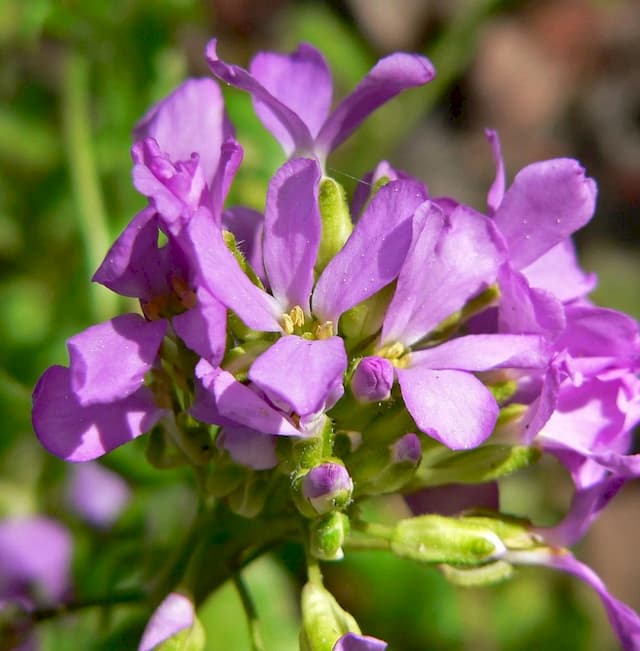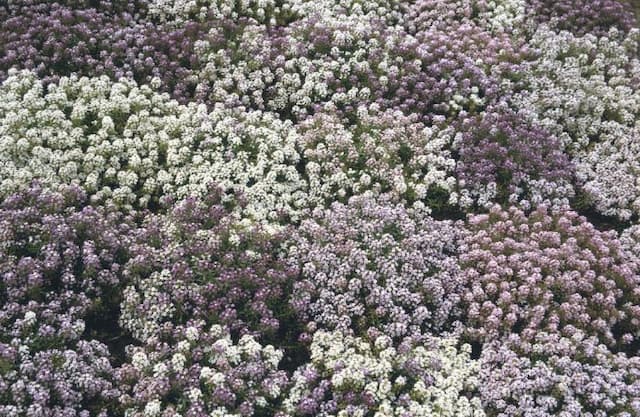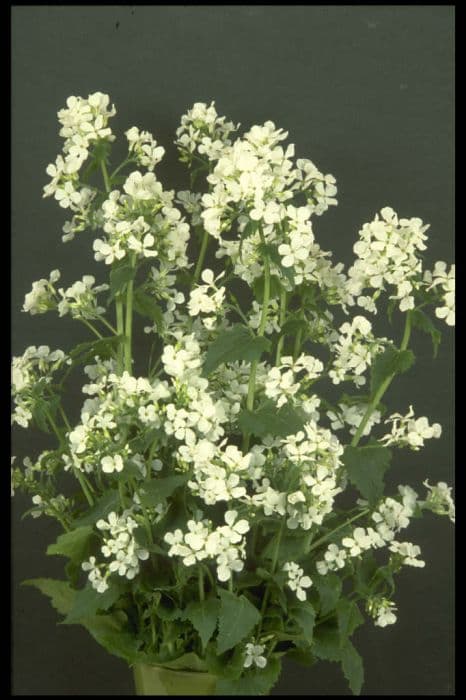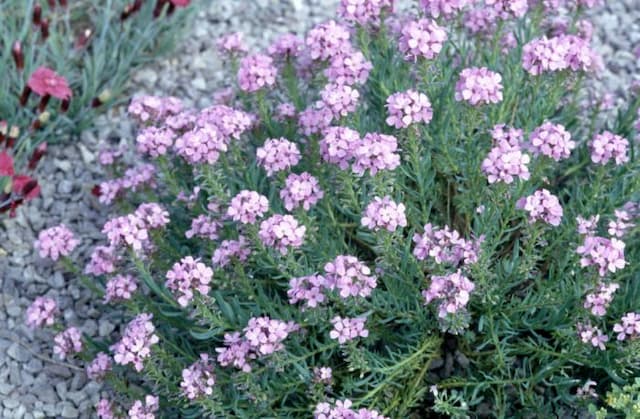Wallflower Erysimum 'Bredon'

ABOUT
Erysimum 'Bredon', often known as wallflower, is a striking plant beloved for its showy display and vibrant colors. This perennial has a bushy, upright habit with narrow, lance-shaped leaves that are a deep green color. The foliage creates a dense backdrop for the profusion of flowers that bloom in the spring and often again in the fall. The blossoms of Erysimum 'Bredon' are its most captivating feature. They are produced in clusters at the ends of the stems and boast a radiant blend of colors, typically ranging from warm oranges to golden yellows and sometimes with a hint of purple or red. The individual flowers have four petals, arranged in a cross shape typical of the family, and exude a delightful fragrance that is particularly noticeable on sunny days or in the early evenings. This wallflower variety is a favorite among gardeners for its long blooming season and ability to attract pollinators such as butterflies and bees. Despite its ornamental appeal, Erysimum 'Bredon' is also known for its hardiness and can be a resilient addition to borders, flower beds, and garden spaces where a pop of color is desired. It is a plant that combines beauty with robustness, offering a captivating sight for anyone who beholds it.
About this plant
 Names
NamesFamily
Brassicaceae
Synonyms
Wallflower, Bredon Wallflower, Perennial Wallflower, Shrubby Wallflower
Common names
Erysimum 'Bredon'.
 Toxicity
ToxicityTo humans
Erysimum 'Bredon', commonly known as 'Wallflower', is not widely recognized for having significant toxicity to humans. However, it is generally advised that plant material should not be ingested, as it can potentially cause gastrointestinal upset or discomfort.
To pets
The Wallflower is also not specifically known to be toxic to pets. However, as with humans, ingestion of the plant should be avoided as it might cause mild gastrointestinal upset in some animals. If a pet is observed eating this plant, it is wise to monitor them for any signs of discomfort or illness and consult a veterinarian if any concerning symptoms arise.
 Characteristics
CharacteristicsLife cycle
Perennials
Foliage type
Evergreen
Color of leaves
Grey-green
Flower color
Mixed
Height
2 feet 6 inches (0.76 meters)
Spread
1 foot 8 inches (0.51 meters)
Plant type
Shrub
Hardiness zones
7
Native area
Europe
Benefits
 General Benefits
General Benefits- Attracts Pollinators: Erysimum 'Bredon', commonly known as Wallflower, is known to attract bees, butterflies, and other beneficial insects to the garden.
- Low Maintenance: Wallflower typically requires minimal care once established, making it suitable for gardeners seeking plants that don't demand a lot of attention.
- Drought Tolerance: Once established, Wallflower is considered drought-tolerant, making it an excellent choice for water-conscious gardens and xeriscaping.
- Long Blooming Period: Wallflowers often have a prolonged blooming period, providing color and interest in the garden for an extended time.
- Aesthetic Appeal: With its vibrant flowers and foliage, Wallflower can enhance the beauty and appeal of garden beds, borders, and containers.
- Compact Growth: Erysimum 'Bredon' typically has a compact growth habit, which allows it to fit well in smaller spaces or as an edging plant.
- Versatility in Landscape Design: Wallflower's striking colors and forms make it versatile for various landscape designs, from traditional cottage gardens to modern urban spaces.
 Medical Properties
Medical PropertiesThis plant is not used for medical purposes.
 Air-purifying Qualities
Air-purifying QualitiesThis plant is not specifically known for air purifying qualities.
 Other Uses
Other Uses- Erysimum 'Bredon', commonly known as Wallflower, can be used as a natural dye. The flowers and leaves may be boiled to extract a subtle color for fabrics or craft projects.
- Wallflower petals can be utilized in the art of flower pounding, where the pigments are transferred to paper or fabric to create a botanical print.
- The plant can serve as a companion plant in vegetable gardens to attract beneficial insects such as bees and butterflies for pollination.
- Wallflowers can be pressed and included in herbarium collections for botanical education and documentation purposes.
- The Erysimum 'Bredon' can be grown in containers and used to add color to urban balconies and patios that receive limited sunlight.
- The blooms of the Wallflower might be dried and included in potpourri mixes to add a sweet, mild fragrance to rooms.
- In landscape design, Erysimum 'Bredon' can be used to create vibrant low borders or edges for pathways.
- When planted in mass, Wallflower can act as a living mulch, helping to retain soil moisture and suppress weeds.
- Erysimum 'Bredon' can provide ground stabilization in sloped garden areas due to its moderately extensive root system.
- Creative use of Wallflowers involves crafting natural floral arrangements where the flowers provide a burst of color amongst greenery due to their vivid hues.
Interesting Facts
 Feng Shui
Feng ShuiThe Wallflower is not used in Feng Shui practice.
 Zodiac Sign Compitability
Zodiac Sign CompitabilityThe Wallflower is not used in astrology practice.
 Plant Symbolism
Plant Symbolism- Resilience: Erysimum 'Bredon', commonly known as Wallflower, symbolizes resilience due to its ability to grow in tough conditions, such as in cracks in walls or rocky terrains.
- Faithfulness: The Wallflower signifies fidelity and constancy, often associated with its perennial nature and long-lasting blooms that return yearly.
- Adversity: Given its ability to withstand challenging environments, the Wallflower represents overcoming adversity and thriving despite hardships.
- Friendship: Because of its pleasant fragrance and colorful presence, Wallflowers symbolize enduring friendship and the giving of positive thoughts.
 Water
WaterThe Wallflower 'Bredon' should be watered deeply and thoroughly to ensure the root system is well-hydrated. During the growing season, water the plant once a week with approximately 1 gallon of water each time, depending on the weather and soil moisture levels. In hot and dry periods, it may require more frequent watering. It's important not to overwater, as the Wallflower prefers well-drained soil and can be prone to root rot if left in soggy conditions. During the winter, reduce watering frequency, as the plant requires less moisture when its growth slows down.
 Light
LightWallflower 'Bredon' thrives in full sun to partial shade, with a preference for a location that receives at least 6 to 8 hours of direct sunlight each day. However, it can tolerate some light afternoon shade, especially in climates with hot summers. Ensure the plant doesn't receive too much intense afternoon sun, which could stress it, particularly in warmer zones.
 Temperature
TemperatureThe Wallflower 'Bredon' prefers a temperate climate and is hardy in a range of environments. The ideal temperature conditions for this plant are between 60°F and 75°F. It can withstand minimum temperatures down to around 20°F but will suffer if exposed to prolonged temperatures below this threshold. It can also manage in higher temperatures, up to about 85°F, but it's best to provide some afternoon shade if the temperature rises beyond this.
 Pruning
PruningPruning the Wallflower 'Bredon' is necessary to maintain its shape, encourage new growth, and prolong blooming. Prune in late spring or early summer after the first flush of flowers begins to fade, cutting back by about one-third to promote a second bloom. Additionally, deadheading spent flowers regularly will also encourage new blooms. Pruning back woody stems every few years will help rejuvenate the plant.
 Cleaning
CleaningAs needed
 Soil
SoilWallflower 'Bredon' thrives best in well-draining soil with some organic matter mixed in, like compost or well-rotted manure. A soil pH range of 6.5 to 7.5 is ideal for this plant. A mix of loam, sand, and organic matter can create the perfect environment for robust growth.
 Repotting
RepottingWallflower 'Bredon' doesn't typically require frequent repotting as it is often grown as an annual or short-lived perennial. If planted in a container, repot every 2 to 3 years or when the plant appears to be outgrowing its pot.
 Humidity & Misting
Humidity & MistingWallflower 'Bredon' prefers moderate humidity levels; however, it is quite adaptable and tolerant of different humidity conditions, making it suitable for a variety of garden settings.
 Suitable locations
Suitable locationsIndoor
Place in bright light, well-drained soil, and water sparingly.
Outdoor
Plant in full sun, well-draining soil, and space 12 inches apart.
Hardiness zone
7-10 USDA
 Life cycle
Life cycleErysimum 'Bredon', commonly known as Wallflower, begins its life cycle as a seed, which after a period of dormancy, typically germinates in warm, moist soil conditions. Upon germination, it develops a root system and a small rosette of leaves during the seedling stage. The plant then enters a vegetative stage, where it grows actively and produces a larger foliage mass. After reaching maturity, the Wallflower enters the flowering stage, producing bright, fragrant flowers that attract pollinators and subsequently, if pollination occurs, it sets seeds. Once the seeds mature, they are dispersed, and the parent plant often dies, although some varieties may survive for multiple seasons as short-lived perennials. The cycle can then start anew when the seeds find suitable conditions for germination.
 Propogation
PropogationPropogation time
Spring-early summer
The most popular method of propagation for the Wallflower 'Bredon' (Erysimum 'Bredon') is by semi-hardwood cuttings. This typically takes place in late summer, where you select a healthy piece of the current year's growth that has begun to mature but is not yet fully woody. Cuttings should be about 4-6 inches (10-15 centimeters) in length with a few sets of leaves. The lower leaves should be removed and the cut end can be dipped in rooting hormone powder to encourage root growth. These cuttings should then be planted in a well-draining soil mix and kept moist but not waterlogged. Providing a humid environment by covering the pot with a plastic bag or placing it in a propagator can increase the chances of successful root development. Once roots have formed, which can take several weeks, the new plants can be potted on or planted out.


![Aubrieta [Axcent Lilac]](/_next/image?url=https%3A%2F%2Fplants-admin.emdemapps.com%2Fimages%2Fplants%2F%2Fimages%2F604b5e2430fac.png&w=640&q=75)






